IDF 2009 - World's First Larrabee Demo, More Clarkdale, Gulftown
by Anand Lal Shimpi on September 22, 2009 12:00 AM EST- Posted in
- Trade Shows
Sean Maloney is getting his speaking practice in and he was back during the afternoon for the second set of keynotes at IDF. This one is a bit more interesting.
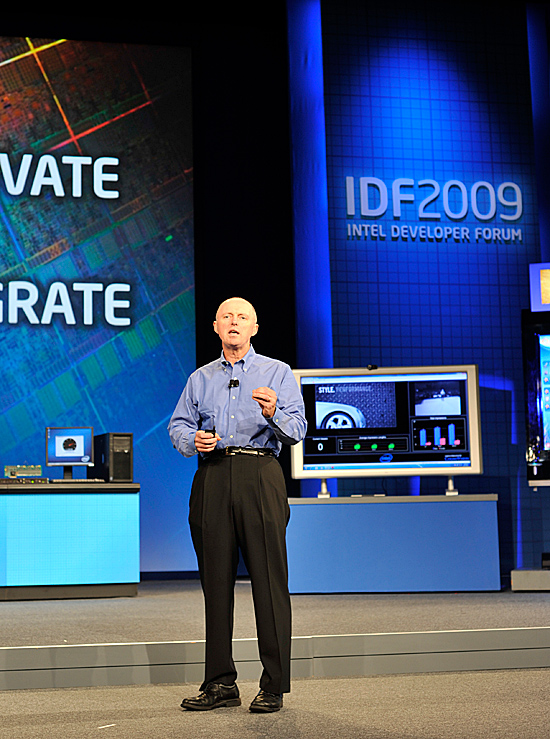
Sean started by tackling Pat Gelsinger's old playground: Servers. Nehalem-EX (8-core Nehalem) was the primary topic of discussion, but he also demonstrated the new 32nm Westmere-EP processors due out next year.
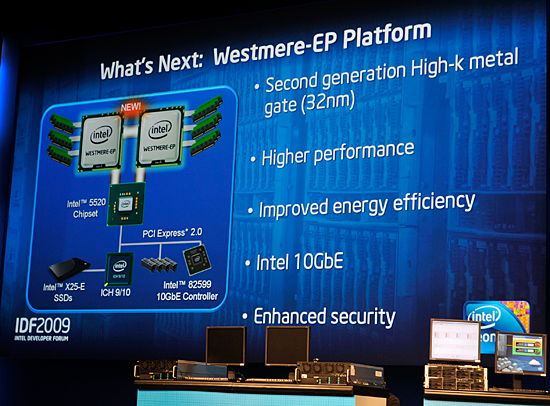
Westmere-EP is the dual-socket workstation/server version of Westmere (aka 32nm Xeon). The feature-set is nearly identical to Westmere on the desktop, so you get full AES acceleration for improved encrypt/decrypt performance. This is particularly useful for enterprise applications that do a lot of encryption/decryption.
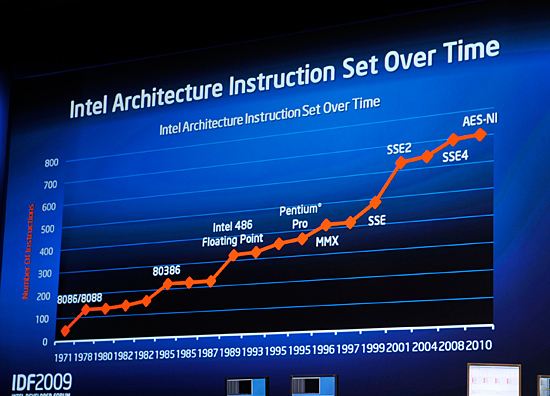
The AES-NI instructions get added to x86 with Westmere. The x86 ISA will be over 700 instructions at that point.
The other major change to the Xeon platform is networking support. The Westmere-EP platforms will ship with Intel's 82599 10GbE controller.
Power consumption should be lower on Westmere and you can expect slightly higher clock speeds as well. If Apple sticks to its tradition, you can expect Westmere-EP to be in the next-generation Mac Pro.
What if you built a Core i7 using 1000nm transistors?
Intel has been on an integration rampage lately. Bloomfield integrated the memory controller and Lynnfield brought the PCIe controller on-die. Sean held up an example of what would happen if Intel had stopped reducing transistor size back in the 386 days.
Here's an image of what the Core i7 die would look like built using ~1000nm transistors instead of 45nm:

That's what a single Core i7 would look like on the 386's manufacturing technology
Assuming it could actually be built, the power consumption would be over 1000W with clock speeds at less than 100MHz.
Next he held up an Atom processor built on the same process:
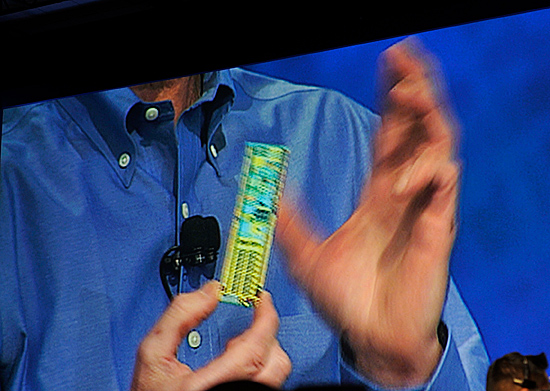
And that's what Sean Maloney shaking an Atom built on the 386's manufacturing process would look like
Power consumption is a bit more reasonable at 65W, but that's just for the chip. You could drive a few modern day laptops off of the same power.
Useful comparisons? Not really, interesting? Sure. Next.
Larrabee Demo
Larrabee is of course at IDF, but its presence is very muted. The chip is scheduled for a release in the middle of next year as a discrete GPU.
Bill Mark, a Senior Research Scientist at Intel, ran a raytracing demo using content from Enemy Territory Quake Wars on a Gulftown system (32nm 6-core) with Larrabee.

The demo was nothing more than proof of functionality, but Sean Maloney did officially confirm that Larrabee's architecture would eventually be integrated into a desktop CPU at some point in the future.
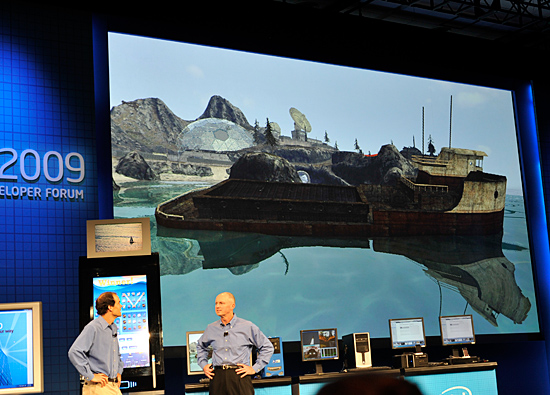
Larrabee rendered that image above using raytracing, it's not running anywhere near full performance
Clarkdale: Dual Core Nehalem
Clarkdale is the desktop dual-core Nehalem due out by the end of this year with widespread availability in Q1 2010.

Clarkdale will be the ideal upgrade for existing dual-core users as it adds Hyper Threading and aggressive turbo modes. There's also on-package 45nm Intel graphics, which I've heard referred to as finally "good enough" graphics from Intel.
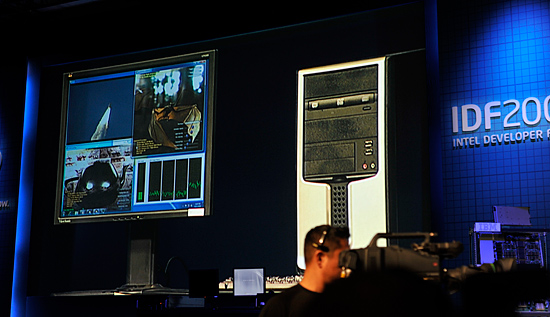
Two cores but four threads, that's Clarkdale
Jasper Forest
Take Nehalem with three DDR3 memory channels, add PCIe 2.0 and RAID acceleration and you've got Jasper Forest. Due out in Q1 2010 this is a very specific implementation of Nehalem for the embedded and storage servers.
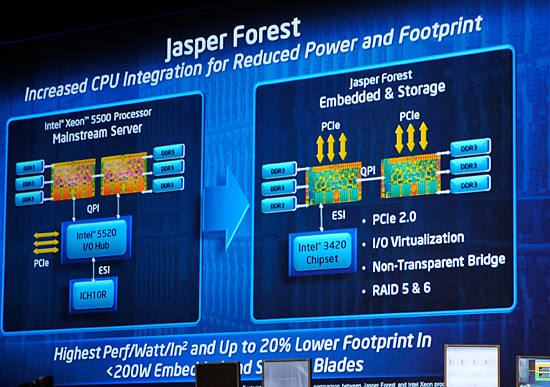
Nehalem was architected to be very modular, Jasper Forest is just another example of that. Long term you can expect Nehalem cores (or a similar derivative) to work alongside Larrabee cores, which is what many believe Haswell will end up looking like.

Gulftown: Six Cores for X58
I've mentioned Gulftown a couple of times already, but Intel re-affirmed support for the chip that's due out next year.

Built on the 32nm Westmere architecture, Gulftown brings all of the Westmere goodness in addition to having 6-cores on a single die.
Compatibility is going to be the big story with Gulftown: it will work in all existing X58 motherboards with nothing more than a BIOS update.










47 Comments
View All Comments
maomao0000 - Sunday, October 11, 2009 - link
http://www.myyshop.com">http://www.myyshop.comQuality is our Dignity; Service is our Lift.
Myyshop.com commodity is credit guarantee, you can rest assured of purchase, myyshop will
provide service for you all, welcome to myyshop.com
Air Jordan 7 Retro Size 10 Blk/Red Raptor - $34
100% Authentic Brand New in Box DS Air Jordan 7 Retro Raptor colorway
Never Worn, only been tried on the day I bought them back in 2002
$35Firm; no trades
http://www.myyshop.com/productlist.asp?id=s14">http://www.myyshop.com/productlist.asp?id=s14 (Jordan)
http://www.myyshop.com/productlist.asp?id=s29">http://www.myyshop.com/productlist.asp?id=s29 (Nike shox)
wumpus - Wednesday, September 23, 2009 - link
Look closely at some of those slides. See that "number of instructions" chart? It goes down to 1971 or so (presumably the 4004).Question: Does this chart include BiiN (billions invested in nothing?), how about the 432? You didn't think the latest 860 was the only intel chip by that name did you (they had a failed RISC architecture by that name as well)? Howabout the not-so-recent and hardly-mourned Itanic? They also seem to leave out the latest huge improvement, AMD64, completely.
ProDigit - Wednesday, September 23, 2009 - link
Lol @ Nehalem @ 1000nm! It looks like a mobo!haukionkannel - Wednesday, September 23, 2009 - link
Well this the chip that makes real harm to AMD. It can be really cheap to produce and offer anough speed to allmost everyone. So it will compete directly with new AMD Athlons.Interesting chip to budged range in anyway. Just hope that AMD gets their new production faclilities runnig sooner than later. I really hate monopolies, even they make exelent products...
vol7ron - Wednesday, September 23, 2009 - link
Already said it once, will say it again: desktop cores are about maxed out, with regards to the need. The gains in speed are almost negligible in the fact that, yes it's faster, but it's not as big as a deal any more. Core2 revolutionized things.I will like to see a 50 core, 20GB cache CPU running on 100Watts. When I can get that in my home system, I'll be happy (and it's just around the bend).
I'm more excited about getting USB 3.0 and SATA 3.0 on motherboards. I'd also be just as excited if Intel put some of that nanotech towards the DRAM and more efforts towards SSDs. How about a processor that is closer to the southbridge, maybe one that integrates with an SSD. I want to see Intel revolutionize the internals as a whole, not just parts of the whole. Another example that this could be done by removing the need for RAM.
SaolDan - Monday, May 13, 2019 - link
this is a funny comment to read in 2019.the zorro - Tuesday, September 22, 2009 - link
i think we have more chance to see the sasquatch than the larrabee.what a failure.
i think many intel fanboys will get old before they can see larrabee.
anyway
not that i care.
Eeqmcsq - Tuesday, September 22, 2009 - link
If you didn't care, why did you mention it?TA152H - Tuesday, September 22, 2009 - link
What confuses me is why anyone would want to use x86 for anything, unless they had to.It's nuts. It was considered a lousy chipset when the 8086 was new. Why are they still introducing new products, in a market where x86 isn't necessary? It's weird.
TA152H - Tuesday, September 22, 2009 - link
I meant, a lousy instruction set.I'm really surprised Intel wanted this. It has to put them at a disadvantage compared to AMD and NVIDIA, not that NVIDIA will matter too much longer.